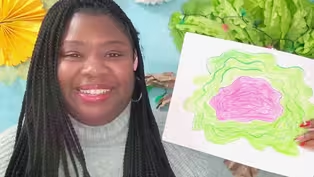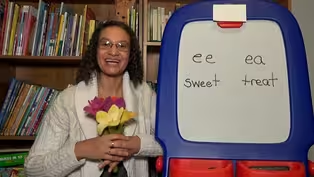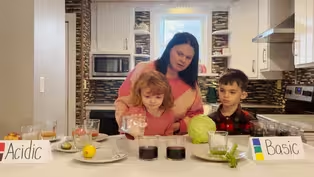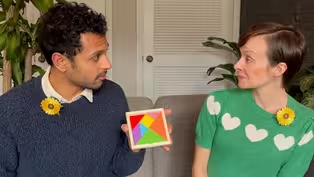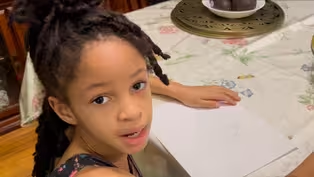
RAINING
Clip: 5/19/2023 | 7m 31sVideo has Audio Description, Closed Captions
Darlene Thomas reads RAINING by Pingping Xu with illustrations by Graca Lima.
Darlene Thomas reads RAINING by Pingping Xu with illustrations by Graca Lima. The book explores how animals like cats, frogs, mice, and birds shelter in their homes when it rains. Then, using a photo as a reference, Darlene shows how to draw one of her favorite plants.
See all videos with Audio DescriptionADProblems playing video? | Closed Captioning Feedback
Problems playing video? | Closed Captioning Feedback
Let's Learn is a local public television program presented by THIRTEEN PBS

RAINING
Clip: 5/19/2023 | 7m 31sVideo has Audio Description, Closed Captions
Darlene Thomas reads RAINING by Pingping Xu with illustrations by Graca Lima. The book explores how animals like cats, frogs, mice, and birds shelter in their homes when it rains. Then, using a photo as a reference, Darlene shows how to draw one of her favorite plants.
See all videos with Audio DescriptionADProblems playing video? | Closed Captioning Feedback
How to Watch Let's Learn
Let's Learn is available to stream on pbs.org and the free PBS App, available on iPhone, Apple TV, Android TV, Android smartphones, Amazon Fire TV, Amazon Fire Tablet, Roku, Samsung Smart TV, and Vizio.
Providing Support for PBS.org
Learn Moreabout PBS online sponsorship- Hi friends, my name is Darlene Thomas and I'm so excited to read a story for you today.
The title of the book is called "Raining", written by Pingping Xu and illustrated by Graca Lima.
Plus, after the story, we'll talk about the importance of rain and how it helps the plants to grow.
And I'll show you how you can make your own picture of your favorite plant.
So, let's get started!
"Rumbling, rolling thunder.
Cheep cheep cheep!
The chick shelters in the hen house.
Meow, meow, meow.
The kitty shelters in the baskets.
Bow wow.
The puppy shelters in the dog house.
Baa!
The lamb shelters in the sheep pen.
Moo, moo, moo.
The calf shelters in the barn.
Oink, oink, oink.
The piggy shelters in the pigsty.
Neigh, the pony shelters in the stable.
Squeak, squeak, squeak.
The little mouse shelters in the burrow.
Tweet, tweet, tweet.
The little bird shelters in the nest.
Chirp chirp chirp.
The cricket shelters in the grass.
Buzz, the bee shelters in the flower.
Croak, croak, croak.
The frog shelters in the pond.
Ah, the baby shelters in the house.
Why?
Splish, splash, patter, patter.
It's raining!
The end.
I hope you enjoyed that book as much as I enjoyed reading it to you.
Now, in the story, the author asks, why does the baby shelter inside the house when it rains?
Do you know why?
Well, that's because most humans and land animals prefer to stay inside when it rains to keep dry.
But plants love when it rains because plants need water to grow.
When it rains, the water goes down into the ground and the plants soak up the water that they need through the roots and the stems of the plants.
You know, when I look outside the window or I'm walking around in my environment, I always notice the plants around me.
Do you notice the plants around you?
What do you see?
You can look out the window.
Maybe you have a house plant, or maybe you just know the plant that you really like.
Today I'd like to invite you to draw that plant.
You can ask a trusted adult to print one out for you on the internet.
So maybe you can copy and draw what you see.
Or you can go on a neighborhood walk and take pictures of plants outside and use those pictures to draw your favorite plants.
Now I'm going to show you how I draw a really awesome plant that I found in my neighborhood.
It's called an ornamental cabbage.
And what's so cool about it is that it looks like a vegetable, but it also looks like a flower and comes in one of my favorite colors, a nice mix between purple and pink.
So I'll show you how I draw my ornamental cabbage flower.
And then you'll be invited to draw your own flower at home.
Let's get started.
All you'll need for this activity is some white drawing paper and a picture of the plant that you'd like to draw and some crayons.
So I'm going to look at my photo and I notice the colors that I'm going to need are mostly dark pink, some purple and some green, 'cause I'm gonna draw up the first one I see.
Okay, so I'm gonna start first with my leaves.
I'm going to take my darker green crayon because when I fill it in with my lighter green, you'll be able to see the outline better.
So what I notice is that I have big leaves on the outside and it keeps going like in a spiral.
So I'm gonna do the same thing on my paper.
I'm gonna make a big leaf And keep going around like a spiral.
And I'm gonna do that a couple of times 'cause there's lots of green leaves.
And I'm gonna stop here 'cause I wanna make some room for that purple.
I'm gonna go in with a darker purple first.
And I'm gonna do the same outline like I did for my green leaf.
And I'm gonna make about 1, 2, 3, about three of these, so two, and three.
Wow.
So now I'm gonna go ahead with my lighter colors and I'm going to color that in.
And so I'm just finishing up adding my lighter shade of purple.
And it looks like maybe I'm taking like a bird's eye view, like I'm looking directly down into the center of the plants, which I love.
In real life, these plants have so many layers.
It's such an awesome plant, in my opinion.
And I'm all done.
Wow, I think my drawing looks just like the ornamental cabbage that I see growing in my neighborhood.
I hope you have as much fun drawing your plant as I had drawing mine.
And the next time it rains, think of all of the beautiful plants on earth that are getting what they need in order to grow and be healthy.
And a healthy earth means a healthy environment.
And a healthy environment means a healthy you.
So enjoy the rain.
Goodbye.
Video has Audio Description, Closed Captions
Clip: 6/12/2023 | 7m 31s | Darlene Thomas reads RAINING by Pingping Xu with illustrations by Graca Lima. (7m 31s)
Video has Audio Description, Closed Captions
Clip: 5/19/2023 | 7m 49s | Lia Zuilivia from Studio in a School draws the lines and shapes of a houseplant. (7m 49s)
LONG E SOUNDS SPELLED EE AND EA
Video has Audio Description, Closed Captions
Clip: 5/19/2023 | 8m | Anna Scretching-Cole explores long e vowel sounds spelled with ee and ea. (8m)
Video has Audio Description, Closed Captions
Clip: 5/19/2023 | 7m 59s | Cassondra Easterling and her children use cabbage water to test the acidity of fruit juice (7m 59s)
Video has Audio Description, Closed Captions
Clip: 5/19/2023 | 11m 37s | Diane Sanlatte teaches a song about the four seasons in Spanish. (11m 37s)
USING TANGRAMS TO MAKE FLOWERS AND TREES
Video has Audio Description, Closed Captions
Clip: 5/19/2023 | 9m 57s | Omar Etman and Lily Fincher show how to use tangrams to make flowers and trees. (9m 57s)
ZURI SHOWS HOW TO DRAW A FLOWER!
Video has Audio Description, Closed Captions
Clip: 5/19/2023 | 59s | Zuri shows how to draw a flower. (59s)
Providing Support for PBS.org
Learn Moreabout PBS online sponsorshipSupport for PBS provided by:
Let's Learn is a local public television program presented by THIRTEEN PBS
